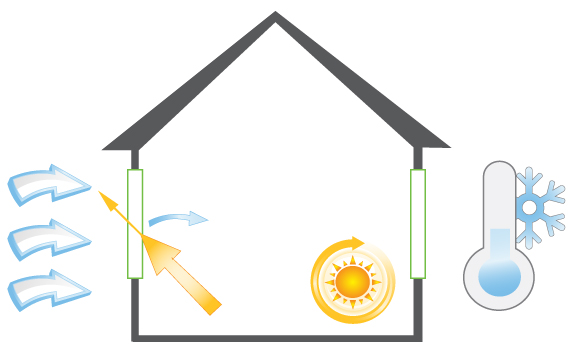Australia's Leading Range of Thermally Broken Aluminium Windows and Doors

The energy cost of heating or cooling your home depends on local climate, insulation, orientation and design factors. On average, Australian homes use 38% of their total energy consumption on heating and cooling their homes.
1. Make sure you have the right insulation
It is important to ensure homes have the correct insulation, in the right places. An important factor in home energy consumption is whether the right ceiling and roof insulation is in place. Reflective insulation such as building foil and sarking works best on the underside of the roof covering whereas bulk insulation such as fibreglass batts work best for the ceiling.
Windows have a role to play in insulation too. Selecting windows with a low Uw value will help you to insulate your home against changes in exterior temperature. After heat lost and gained through your ceiling windows are the next biggest factor influencing the control of your interior temperature.
2. Know where the sun is coming from
By understanding the position of the sun to your building, you can design your home to help keep out unwanted summer heat. It is important to carefully place windows in your main living areas to ensure they provide plenty of natural daylight without allowing too much direct sun to enter into the space. The position and design of eaves can help to shade large windows in the summer months but allow the winter sun to warm your home and provide a natural source of passive heating during the winter months.
When considering the passive design and orientation of your home it is worthwhile looking at the Solar Heat Gain Coefficient (SHGc) values of the windows or doors you plan to use. Windows with low SHGc values work to minimise radiant heat gain for you home – well suited to westerly orientations and warm climate areas. Whilst windows with high SHGc values allow more radiant heat to pass through, which work well in cooler climate or on Southerly orientations where you are looking to allow the warming winter rays into your home.
3. Position windows and doors to maximise natural ventilation
Most of our capital cities are located near the cost, where the difference in temperature between the land and sea often creates cooling afternoon breezes, therefore the strategic placement of windows and doors can assist you in cooling down your home.
By utilising passive design theories in the placement of your windows and doors, your energy costs will be significantly reduced. The effectiveness of passive design is significantly enhanced by insulative (double glazing) or movable window insulation (shutters, shades).
The style of window you choose for your home can have a huge influence on its ability to allow natural ventilation. Vantage sliding stacking doors can be opened up wide to allow large clear access to natural breezes. Awning windows can be a good choice in wet climates allowing you to leave your windows open without letting the rain in. Double-hung windows create a natural convection process which is great for allowing cool air into your home and letting warm air escape.

Energy Loss in a Cold Climate

Energy Loss in a Hot Climate
For further information visit the Liveability Australia website